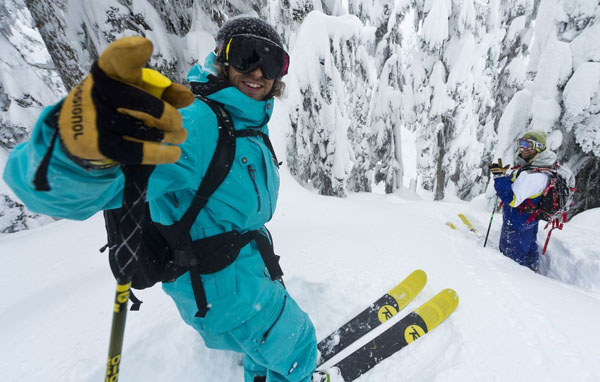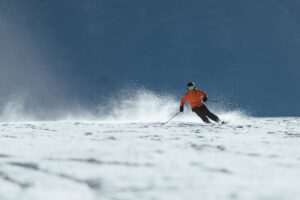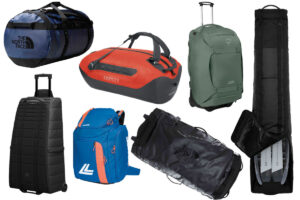
What’s the most versatile ski of the 2013-2014 season? Right now, amongst ski testers on both sides of the Atlantic, there’s an uncommon degree of consensus on that subject. It’s the Rossignol Soul 7. Ever since it was launched at the start of the year (scooping up an ISPO award in the process), it’s been generating excitement and bagging rave reviews.
Why? “Because you can ski it almost anywhere,” says Phil Gordon, Ski Equipment Buyer at the skier’s emporium, Snow+Rock. “It floats through powder, is sure and stable through the crud, and threads tight lines through the trees. For a ski of its size it’s also unusually nimble on groomed pistes.”
Phil first skied the Rossignol Soul 7 at the 2013 SIGB test in Kuhtai, Austria, on a mixture of thin powder, crud and groomed snow – and it was actually the on-piste capability that impressed him most. “This is a ski that’s 136mm at the tip, 126mm at the tail, and 106mm under the boot, so you’d expect it to do well in deep snow. But you’d never guess its edge-to-edge speed in the turn would be so good; nor the way it holds onto hard-packed snow. Officially, it’s designed mainly for off-piste skiing. But it’s as close to a one-quiver ski for advanced skiers as I’ve ever seen.”

At this point, Phil adds that not everyone should be rushing out to buy it. “If you’re only just beginning to dabble in powder, you should go for something skinnier.” Because however good its on-piste performance, the Soul 7 is still 106mm under the boot: roughly 40mm wider than the average race ski. Intermediates – even plucky, athletic ones – are going to find it a handful, and Phil suggests a ski more traditional “all-mountain” ski like the Salomon Q-90 or the Rossignol Experience 88 for them. “But if you’re confident and accomplished skier – level 6 or above – and spend more time off-piste than on, this has your name written all over it,” he says.
Why is it so good? Here are a few contributing factors.
1. It’s fat – and, if you want it, long too.

As we’ve said, this is a fat ski with lots of surface area – especially if you buy it long (it comes in four lengths, 164, 172, 180 and 188cm). This gives it a lot of flotation in powder. That said, Phil suggests that if you’re trading up from a traditional all-mountain ski to the Soul 7, you may not want to buy it as long as a more conventional off-piste charger, such as the old Squad 7, because you’ll sacrifice some of the Soul 7’s eye-popping manoeuvrability in the process.
2. For an off-piste ski, it has a deep sidecut
Notice how much shape the Soul 7 has in the middle section. This is a deep sidecut for an off-piste ski, and as a result the turn radius is 17m, just 4m more than Head’s Worldcup Rebels slalom ski. This is one of the reasons it carves so well on-piste and and turns so easily at lower speeds in powder.
3. The Powder Turn Rocker is good for both pistes and powder
Seen side-on, the Soul 7 has a complicated shape – with a turned-up tip and tale (“rocker”) and a concave arch (“camber”) under the boot. Rossignol’s name for the shape is Powder Turn Rocker: The camber under the boot helps it carve and grip on piste, and the rocker ensures that – while it has plenty of float in powder – it’s much easier to turn than a flat ski would be.
4. On-piste it feels like a short, manoeuvrable ski
Check out the shape of both the front and back end of the ski. The yellow tip and tail are both long and tapered. That helps with the manoeuvrability of the ski in powder: it also means that contact point with the snow, when it’s on piste, is set well back from the ends of the ski (this video explains the point well). So when you’re skiing the corduroy it feels like a much shorter ski than it really is.
5. The tip doesn’t flap as much as it does on some rockered skis

One of the most exciting features of the Soul 7 is the honeycomb “Air Tip” construction of the tip and tail. This means less weight at either end of the ski, in those sections that aren’t in contact with the snow when you’re on hard-pack or in crud. As a result, some ski testers report less flap and chatter from the Rossignol Soul 7 in more challenging conditions.
6.It’s light
It’s not just the honeycomb tip and tail that keep the weight of the ski down, but the paulownia wood core. In fact it’s so light that ski tourers are planning to use it over the coming season – and Rossignol has produced a pre-cut climbing skin to help them (this isn’t available yet in the UK, but you can get it in France). But that doesn’t mean it’s soft: and performance in lumpy crud is very good.
7.The binding mount point is good
This is something Michael Meier, director of the ski school and sports shop Stoked in Zermatt has pointed out. He’s another big fan of the Soul 7 (in his opinion, “it’s the future of skiing”). He says, “Rossignol is one of few the brands on the market which gets the mounting point of the bindings right: many manufacturers have it set too far back, making the ski tail-heavy. As a result it’s hard to bring pressure to bear on the nose and make the ski work properly”.
So is there anything the Soul 7 doesn’t do? Well, as you’d expect from such a light ski, with so much sidecut, it’s not as stable as some when it comes to straight-lining down a mountain at high speed. Judging by the comments of the hard-charging pros featured in Rossignol’s promotional video, below, it’s seen more as a light, manoeuvrable, ‘fun’ ski for mucking about on when visibility isn’t so good. Not something you’d take on a heliskiing video shoot.
But that shouldn’t bother skiers who aren’t quite as strong and skilful, and don’t have a production company heliskiing budget. After all, they’re going to be skiing at lower speeds and on more variable terrain and snow: and for them the consensus is this that is a fantastic ski. In fact, the buzz around the Soul 7 has completely overshadowed the other skis in Rossignol’s freeride range, the Squad 7, the Super 7, the Sin 7 and the Smash 7. You can’t help wondering if the company quite realised just what a superstar they’d created when they released it.
If you’d like to see some more Soul 7 footage, check out this video of a day on Soul 7s in the Retallack cat-skiing range in Canada.

















The most versatile ski of 2013? https://t.co/eiVAhM7QCU
There’s a storm coming. Soon to be followed by snow. It’s almost ski time. Hence, first ski tweet for the season https://t.co/4GZIoZLPEl
“This is a deep sidecut for an off-piste ski, and as a result the turn radius is 17m, just 4m less than Head’s Worldcup Rebels slalom ski. – ”
Am I misunderstanding this or should that not read ” just 4m more than Head’s ..slalom ski ” ?
RT @welove2ski: The most versatile ski of 2013? https://t.co/eiVAhM7QCU
We love to ski share their views on this years must have skis, the Rossignol Soul 7 https://t.co/3Qsb6uGWRc